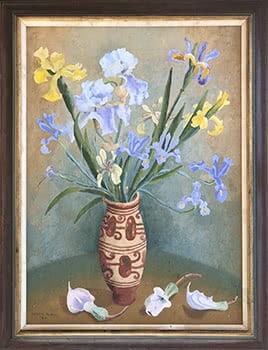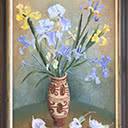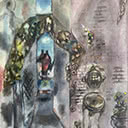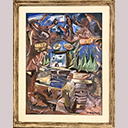Still Life with Irises
76 x 54.5 cm
est. $150,000 - 200,000
PROVENANCE
Private Collection, Auckland
Purchased 1962 by current owner
Frances Hodgkins first met Cedric Morris in Cornwall in 1918, becoming firm friends with him and his partner Arthur Lett-Haines, commonly known as Lett. Their friendship flourished for the rest of Hodgkins' life, both valuing their independence but respecting, indeed cherishing the critique each would provide of each other's work. In 1929, Morris nominated Hodgkins as a member of the Seven and Five Society, which had risen from conservative beginnings to represent the avant-garde in British art. Born into an aristocratic Welsh family, Morris preferred the bohemian life of an artist, and like Hodgkins, found the impetus for his own kind of modernism in Paris, where he and Lett spent extended periods, studying, observing, and in turn, carousing. Lett was also an artist, but often put his own work aside to look after the running of Benton End, near Hadleigh in Suffolk, which replaced The Pound, their original home near Flatford Mill. At Benton End they set up the East Anglian School of Painting and Drawing, some of the more outstanding students being Lucien Freud and Maggie Hambling. While Lett took care of the entertaining, as well as contributing when applicable to teaching, Cedric set about creating what was to become one of Suffolk's most famous gardens. He planted his garden with the eye of an artist, knowing instinctively how to juxtapose various tones and shades to get the best effect. Irises were his favourites, and he became a renowned breeder, enabling him to create an extensive range of tones, textures, and patterns within his plants. When he painted, however, Morris was able to combine his skills with his brush with his plantsman's knowledge of the structure of each of his irises. In many of his flower paintings, the plants rise as if from the ground itself, crowding the foreground in its entirety, as if we are looking at a forest, the receptacle containing them hidden from view. When examined carefully, however, we see that each flower has its own space. Like Hodgkins, he sometimes painted from memory, whereas in his vase still lifes, one senses he has picked his favoured stems to enjoy them in his studio. As a frequent traveller to Europe, as well as North Africa, Morris had plenty of opportunities to buy the kind of vessel we see in Still Life with Irises - an unglazed, earthenware hand-painted vase, the simple red ochre design standing out on the rustic clay form. Unlike Frances Hodgkins, Morris had a home to return to, and was therefore able to collect ceramics for use at Benton End. Hodgkins adored ceramics and porcelain, their forms an integral life of her highly successful still lifes in landscapes, but she learned early on to resist acquiring them, as they inevitably broke in her suitcase. However, as a frequent visitor to Benton End, she could at least enjoy them second hand. Morris is playing games with perspective in Still Life with Irises, for while the table is placed hard up against a corner, its gradation from brown ochre in the foreground to almost black at its furthest edges accentuating its depth, its raised surface breaking down any sense of true perspective. Its angularity is not reflected in his treatment of the plastered wall behind it, which has a much softer treatment, shadows built up with dabs of ochres and bluish greys. Morris has used a loaded brush used to create a dense impasto, so that we sense the texture of the plastered walls, evoking a Mediterranean warmth rather than the chill of an English Spring. The placement of the vase in the foreground again adds to the sense of depth, each iris existing in its own space. The narrow petals of the Dutch irises, some with plicata or coloured edges, bend and bow in the vase, while Morris has painted the broader petals of his favourite bearded irises in a range of pale lilacs, highlighted with delicate tones of yellow ochre. In the foreground he has included three pink and white blooms of Arisaema candidissimum or Chinese cobra lilies. Originally from China, like the irises they are late Spring flowers, indicating the season when Morris painted this beautiful work. Famed for their perfume, their inclusion adds another sensory element, transporting us from the chilly winds of Suffolk to an evocation of sunnier climes.
MARY KISLER





